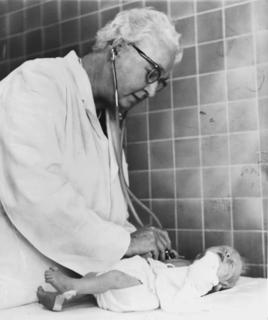Dr. Virginia Apgar
She probably helped you be born

Dr. Virginia Apgar examines a newborn baby. (1966).
Public Domain. Source: National Library of Medicine.
Timeline of Dr. Apgar's Life:
- 1909 - Born in Westfield, New Jersey
- 1925 - Graduates high school determined to be a doctor, spurred by her father's scientific hobbies and having witnessed one brother die from tuberculosis and another suffer from a chronic illness
- 1929 - Graduates Mt. Holyoke College with a major in zoology and minors in physiology and chemistry, generally being an overachiever, even pursuing her lifelong hobby of the violin with the university orchestra.
- 1929 - Enters medical school at the College of Physicians and Surgeons of Columbia University just as the Great Depression begins, where she will graduate fourth in her class.
- 1933 - Gets a surgical internship at Columbia. While there, she is advised by her program director Dr. Alan Whipple (inventor of the pancreaticoduodenectomy, aka Whipple, procedure) to pursue the nascent field of anesthesiology, because it was hard out there for a female surgeon in the 1930s.
- 1937 - Completes her surgical residency; seeks training in anesthesia. Since it wouldn't even recognized as a medical specialty for nearly a decade, she exhibits hustle once again, and finds her way over to UW Madison, where she trains for half a year in the nation's first department of Anesthesia before returning to New York to train for another half a year at Bellevue.
- 1938 - She returns to Columbia Med as an attending anesthesiologist, and director of the department, of which she was the only member. The struggle remains real, since the work is less respected and less well-paid than surgery, to the point that she can't find people to hire.
- 1946 - Anesthesia becomes a recognized specialty, which means that doctors must get residency-trained in it to practice it.
- 1949 - Dr. Apgar becomes the first woman to be a full professor at Columbia's medical school when Anesthesia research becomes an academic department (incidentally proving Dr. Whipple right - he said that she had "the energy, intelligence, and ability needed to make significant contributions in [Anesthesiology].) Her work will focus on obstetric anesthesiology.
- 1952 - Creates a "better medical mousetrap" - a method to tell whether the doctors in the delivery room need to do something to make a newborn baby start breathing. It requires no special equipment, and is easy to calculate.
- 1953 - Publishes the scoring system that she first presented at a conference the prior year. This is the crowning achievement of her career, but she will have to fight to establish its validity, and in her typical badass fashion, she wins. Eventually, it will be remembered by medical students around the world using a mnemonic that immortalizes this god of American medicine: A.P.G.A.R. (short for Activity, Pulse, Grimace, Appearance, Respiration).
- 1959 - Leaves Columbia and gets a Masters in Public Health from Johns Hopkins, and begins to work for the National Foundation for Infantile Paralysis, an organization that will become the March of Dimes.
- 1964 - Becomes an advocate for universal vaccination during the rubella (German measles) pandemic that will cause 20,000 birth defects and 11,000 miscarriages or therapeutic abortions nationwide in just two years.
- 1965 - Begins lecturing at Cornell's medical school.
- 1967 - Becomes Director of Basic Research for the March of Dimes.
- 1971 - Becomes clinical professor of pediatrics at Cornell, teaching teratology, the study of birth defects. Picks up another first en passant, becoming the first doctor to hold a faculty position in this new area of pediatrics. Also becomes the vice president for medical affairs at the March of Dimes.
- 1972 - Writes a book aimed at parents about birth defects with Joan Beck entitled, "Is my Baby Alright?"
- 1973 - Appointed to lecturer in medical genetics at Johns Hopkins.
- 1974 - Dies at age 65.
- 1994 and beyond - Continues to be honored posthumously, including getting a 20-cent US postage stamp made in her honor, which would probably have pleased her, given that stamp-collecting was among the many and varied interests of this fierce, active, and irrepressible doctor whose name graces the very first minute of all our lives.
"[She has] done more to improve the health of mothers, babies, and unborn infants than anyone in the twentieth century."
- Former Surgeon General Julius Richmond
"Nobody, but nobody, is going to stop breathing on me!"
- Virginia Apgar, M.D.
For more information on Dr. Apgar's life and research, you can visit the National Library of Medicine's "Changing the Face of Medicine" page, Wikipedia, The Women of Hopkins, or ACOG.